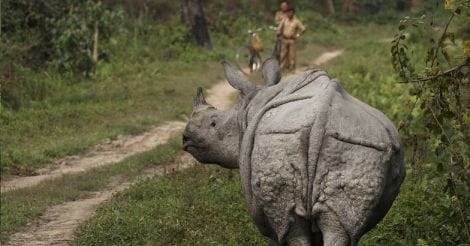One of the main challenges faced by the Indian rhino conservation efforts has been the huge concentration of the animal in just a few areas, like Kaziranga in Assam. This is seriously making them an easy target for poachers who kill them for horns.
The government must think about decentralizing this huge rhino population from Kaziranga to other suitable habitats across Assam, Arunachal Pradesh, North Bengal and adjoining Himalayan foothill areas of Bihar and Uttar Pradesh, bordering Nepal. This will help in better spacing of the hugely concentrated rhinos in one premier habitat to several other suitable habitats and if managed properly, could lead to further increase in rhino populations and facilitate better gene flow among different smaller subpopulations.
Breeding programs between rhinos in Nepal and India (West Bengal and Assam) could be an important step for improving rhino genetics for future conservation efforts and to avoid chances of inbreeding depression. Furthermore, it will help new tourism centers to boom for rhino lovers in different states, not just West Bengal and Assam, and will draw international tourists too.
 Photo: Getty Images
Photo: Getty ImagesThis will also make the poaching activities difficult as the animal will be spread out in different larger habitats and terrains that are not so easy to access. The Indo-Myanmar border areas, as well as North East Indian insurgency operational unit, being far off from Northern and Eastern India will help in curbing poaching pressure effectively.
The strong anti-poaching stand of the Assam and Union Governments and the decision to empower the forest guards with modern army gadgets and tools to carry out counter actions against organized poaching units have drawn both good and bad press across the globe. While some have praised the effort as a strong and robust conservation approach for protecting a flagship species, others like the BBC have criticized the effort for being too aggressive, high handed and irresponsible in causing deaths of several suspected poachers over the past few years.
Although there have been some incidents of innocent villagers or bystanders around the forests in the rhino belt being shot, arrested or harassed for alleged links to poachers, there’s no doubt that it has also reduced the rate of poaching crimes in the state, which is linked to foreign backed insurgent groups. BBC has criticized India for the effort but has kept completely silent regarding the illegal wildlife trade markets that are actively funding rhino poaching operating from China and South East Asia. Possibly, the lucrative television market in China has prompted BBC to be completely silent on Chinese undercover support for illegal, global wildlife trade and insurgent activities in North East India and South East Asia.
 Photo: Getty Images
Photo: Getty ImagesHowever, one important aspect of the BBC report must be highlighted too. The increasing breach of trust between the forest department and the local administration and remote, rural, tribal settlers and villagers living under abject poverty in and around Kaziranga is increasing by the day. This should be immediately addressed by the concerned authorities with necessary action plans and projects.
The administration views the villagers as supporters for the poaching units active in the area while the villagers look at the local administration and the forest department as tormentors. This needs to change. The local administration and the forest department must generate a platform for dialogue with the local villagers and make them stakeholders in the process of rhino conservation.
The socio-economic conditions of these poor communities need to change following some sustainable economic approaches so that the people could also see Kaziranga as a source of their daily bread earners. Their ancient forest rights are being violated and their heavy dependence on the local forests for daily sustenance is pushing them towards encroachments into protected areas and getting into strong conflicts with the forest staff. The path should be of cooperation and collaboration and not of confrontation. The only missing point in India’s glorious conservation effort is the perpetual failure to include local communities as stakeholders in the process of conservation. This angle of Indian rhino conservation effort is now being internationally criticized and needs to be addressed appropriately.
 Photo: Getty Images
Photo: Getty ImagesOnce the strength of the people is incorporated in any conservation efforts, anti-social activities like poaching can be better tackled and handled with a humanitarian perspective. With better economic opportunities, poor communities that fall victim to organized poaching units could be more efficiently prevented from getting involved in this vicious cycle. Hence, an overall a dynamic and comprehensive review of the current Indian rhino conservation program is needed to cater to this majestic mammalian species. When both human and wildlife needs are jointly addressed, conservation efforts get a boost and thereby, build a better future for both wildlife and communities living in close proximity to them.
(The author is a Canada and India based freelance journalist specializing in global geo-political, strategic and foreign policy issues, science & technology and environment & conservation related themes.)

























 Photo: Getty Images
Photo: Getty Images